Geneva Motor Show 2012
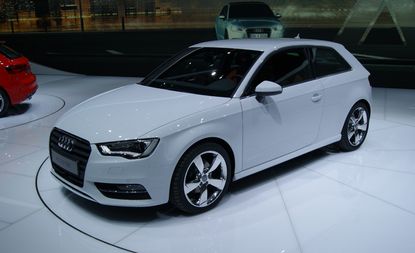
Audi A3
Audi has evolved the design of the compact A3 hatchback to be more in line with its current comprehensive product portfolio. So the exterior features a sharper, more focused front end - incorporating LED daytime running lights - and it retains the car's characteristic thick rear pillar.
'We kept the A3 strong architecture that includes a typical two-box design and a significant bonnet,' explains exterior designer Achim Badstübner. 'The new two-piece tail lamps that features in all Audi cars now gives the A3 a stronger identity in the rear.'
It is inside that the A3 really delivers with the use of soft-touch plastics that almost have a bounce to them and don't seem to leave fingerprint marks, and a slim dashboard. When not in use, the infotainment screen - a touch pad like in the A8 - almost floats above. 'We wanted to bring the upscale technology of the A8 for the A3,' says Badstübner.
On sale: September 2012
Price: Circa £19,000
The car world is a fickle one. For the last couple of years we have been teased with a promise of a future urban setting free of the traditional automobile. We were sold a compelling picture where carbon-free hubs transport us autonomously in this wirelessly connected utopia.
Alas, at this year's Geneva Motor Show there was a conspicuous shortage of such visionary vehicles - a little disappointing given that this is one of the only global car shows where conceptual studies and future thinking are positively encouraged. Instead we were fed a range of pragmatic cars that fit our current (less ideal) urban landscapes, and a host of dreamy sex-fuelled sports cars.
Lamborghini's show car, the Aventador J, is a one-off roadster version of its flagship car, promising 700-horsepower from its 6.5-litre V12 powerhouse. It is undeniably desirable even if to be enjoyed by just one customer (who reportedly bought it for £1.76m). As is Ferrari's F12 Berlinetta, which certainly attracted the most attention at the Geneva Motor Show - the hot red car was barely visible on the stand for the media scrum.
Porsche exhibited the all-new Boxster. Designed to be differentiated from the flagship 911, new doors and subtle tail lamps that integrate into the spoiler succeed in giving this entry-level sports car much more of an individual identity.
On the practical side, Audi and Mercedes-Benz went face-to-face over the small car territory with their respective A3 and A-Class redesigns. In true Audi form, the A3 is chiselled, almost flawless in its execution, if lacking a little in soul. That is not to say it isn't a handsome product and completely right for the marque.
In contrast, the A-Class is bolder - the face exposing an almost jewel-like grille; the sculpture a great deal of surfacing - expressing Daimler's yearning to shed its dated reputation in the design department and jump on the success bandwagon of its German rivals Audi and BMW, who are making relevant cars that resonate with customers all over the world. Whether the A-Class will attract a younger buyer remains to be seen, but it is a vast improvement on its former awkwardly tall predecessor.
With much of Europe in a less than agreeable financial state, carmakers are naturally eyeing up the BRIC markets with hawk-like eyes. It is the needs and wants of Chinese, Indian and increasingly Brazilian customers that is directing what is being designed and engineered in Munich, Stuttgart, Ingolstadt and Coventry.
For example, the main message from Jaguar Land Rover at Geneva was its imminent plans for a joint venture with a Chinese partner, which they have since announced will be Chery. The Tata-owned Jaguar Land Rover was on great form at Geneva - oozing confidence and optimism that was far less visible with some of the other car manufacturers. This is unsurprising given JLR's recent growth and hefty profits, all thanks to some intelligent product planning (with six new launches promised this year).
Jaguar has just 1% share of the premium market in China. Adrian Hallmark, global brand director, told Wallpaper*: 'That is 99% of opportunity. Our tailored-for-China approach helped achieve global XJ growth of 45% in 2011.' Jaguar's show offering, the XF Sportbrake, is production ready. Much like the XF, the estate version is elegant and thoughtful, a simple uptake on Jaguar's heritage with a modern edge. Design director Ian Callum mused that estate cars are very much a European preference, bought by younger customers who associate these smaller estates with sporty lifestyles. In this context it is nice to see Jaguar also focusing its attention in Europe and not completely bowing to other markets.
Land Rover's Geneva offering was the Range Rover Evoque convertible concept. Launched last year, the Evoque has been an incredible success story for the company, bringing swathes of new customers to the marque. The intention of the car was to seduce young female buyers and entice customers from markets where the brand is less known. The convertible's design is an acquired taste, but according to LR's head of design Gerry McGovern he will modify it for production depending on the reaction received. There is no doubt that it would attract an even larger audience, even in its current form.
Rather more compelling is the DC100 concept vehicle. Shown for the first time at Geneva's Palexpo halls, this is the marque's vision for a modern Defender - surely one of the most difficult cars to redesign given its almost cult status amongst its loyal customers, ranging from the Queen to the army. The DC100 softens the square edges, adds a little fun to the light graphics yet crucially maintains the utilitarian vernacular of the Defender. However, unlike the Evoque convertible, this car could polarise the more established Land Rover customers.
Motor shows wouldn't quite work without some eye dazzling concept cars from the traditional Italian design studios Bertone, Pininfarina and Italdesign Giugiaro. Of the three Giugiaro is the only one not mired in financial worries - it has sold a majority stake to Volkswagen. The other two historic design houses still have lucrative contracts with other carmakers but once these expire, their debts place them in a fragile situation.
Harsh reality aside, all three carrozeria put on a great show at Geneva, with Pininfarina leading the way with its intelligent Cambiano concept, a seductive three-door saloon-coupe featuring a wood interior crafted from recycled Venetian palinas. Bertone's offering Nuccio is much louder, a little bit of show theatre - the concept is based on the 1970s Lancia Stratos Zero concept.
Finally it was down to Bentley to create a rather big stir at Geneva with its provocative sports-utility proposition. The EXP 9F is an all-wheel drive concept study examining a potential third product to join Mulsanne and Continental. There is certainly economic logic in a Bentley SUV - the customers have asked for it - but perhaps this wasn't the right answer to the question. The somewhat vulgar exterior design, with its massive grille and 23-inch wheels, was a rare disappointment from the marque. Inside, however, the car expressed an entirely different message, with a crisp cabin design hinting at a rather more fun side of the Bentley design team. As for the exterior, new head of design David Hilton did not hide his concerns, reassuring us that 'there is work to be done on the exterior to get it more refined' for the second and final version - possibly - at the Paris Motor Show in September.
Once again, however, the show's biggest draws were hefty luxury cars powered by 12-cylinder engines. Geneva is historically the best auto show for fantasy designs and future speculation, but in recent years it's rather lost its edge to Frankfurt and Tokyo as the place to go for true technological innovation. The 2012 show reinforced that steady shift.
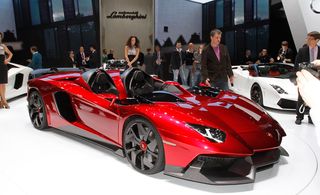
Lamborghini Aventador J
Lamborghini's Aventador J is a two-seater production supercar without a roof or a windscreen - the idea being to have a free-spirited, almost motorbike-like, riding feel. Designed as a one-off for one of the Italian supercar maker's customers, this powerful roadster's 6.5-litre V12 engine promises around 700-horsepower and a top speed of 186mph-plus.
Aventador J's design nods at the forthcoming Lamborghini convertible. It features a new carbon-fibre material called Carbonskin that has special epoxy resins to stabilise the fibres, but keep them soft enough to trim the seats with.
On sale: One off sold
Price: £1.76m
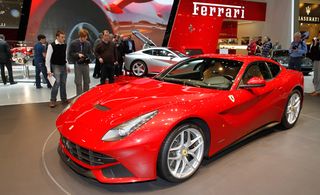
Ferrari's F12 Berlinetta
The F12 Berlinetta is the fastest road car Ferrari has produced. Replacing the 599, its 740-horsepower V12 engine sprints to 60mph in just 3.1 second. Weight has been significantly shed and structural rigidity improved with the use of lightweight metal like aluminium, as well as working with technologies from the aeronautics industry.
The sculpture is short and low and highly aerodynamic; the new hood channels air away from the top of the car, thus reducing downforce and drag. All this means fuel consumption has been lowered and CO2 reduced to 350g/km, relatively low for such a super car.
On sale: Early 2013
Price: Circa £250,000
Wallpaper* Newsletter
Receive our daily digest of inspiration, escapism and design stories from around the world direct to your inbox

Porsche Boxster
The new Porsche Boxster production car has been redesigned in order to gain its own character rather than play second fiddle to the 911. The new car is longer and wider, but lighter and therefore more economical than the previous model.
It's still recognisably a Boxster, but the headlights are now more vertically stacked, the doors are scalloped to flow into the bigger side intakes, a strong crease runs between the tail lamps and integrates with the pop-up rear spoiler, and every line and angle is just a little bit sharper and more dynamic.
Head of Porsche design Michael Mauer agrees that the main target was to have a bigger differentiation from the 911. 'When the Boxster story started 16 years ago, it was the smaller brother of the 911,' he says, 'and then over the second, and now this generation, it has become more of a car on its own with its character and design features.'
The team worked the proportions so the car would look more adult, or 'more of a serious roadster,' as Mauer puts it. 'The Boxster is the right product to introduce new design elements into the brand as it doesn't have such a long history as the 911. It can be more progressive when it comes to the design approach. The 911 is a different story.'
This is the only mid-engine roadster in this segment, 'so we wanted to emphasise on this layout and make this more visible,' Mauer continues. 'We have this bigger air intake that starts at the front of the door and so it visualises this mid-engine layout.'
The folding fabric roof no longer has a panel to drop behind; instead the roof itself now doubles as the cover when the hood is stowed. The interior is a continuation of new design strategy seen on the 911 with the raising centre console.
On sale: May 2012
Price: From £37,589
Mercedes-Benz A-Class
This is the new A-Class, a completely redesigned entry-level car for Mercedes-Benz. The marque has done away with the awkward one-box mini van architecture of the former model, instead opting for a sportier compact hatch to rival the Audi A3 and BMW 1-Series. 'This is a radical change,' admits design director Gorden Wagener.
The design is bold and brave, featuring a great deal of surface movement and sculpting coupled with a rather daring 'diamond grille' design - on the sports version - translated directly from Concept A shown at the Shanghai show last year.
'We tried to maintain the flavour of the original sketch with the narrow greenhouse and wide shoulders that give the car a wider stance,' says the chief designer. 'The surfacing is the interesting side of the car - we created a lot of sculpture to give it sensual surfaces, which is crucial to our design philosophy.'
Crucially the A-Class is the first car in its class to be iPhone compatible - you can slot your smartphone in and connect your personal, work and mobile life seamlessly on the flat screen free floating screen. 'So this car is on-line all the time,' says Wagener. 'It's an iPhone on wheels.'
On sale: December 2012
Price: Not confirmed
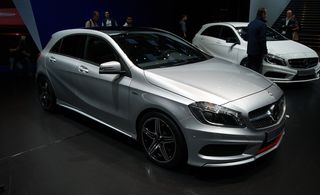
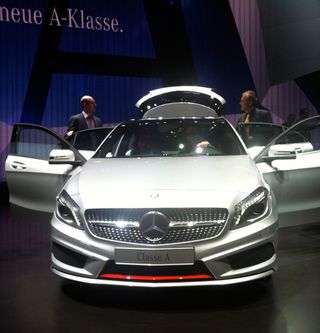

BMW 6 Series Gran Coupe
BMW is expanding the 6 Series range to three models with the introduction of the 6 Series Gran Coupe, the marque's first four-door coupe.
On sale: June 2012
Price: From £61,380
Range Rover Evoque Convertible
Land Rover has taken the roof off the Range Rover Evoque. Only a concept car at this stage, the Evoque convertible has been created to test press and public opinion. If feedback is positive, Land Rover will build a car based on this prototype.
Wallpaper* caught up with Land Rover design director Gerry McGovern at the Geneva Motor Show:
'This is a natural progression for Evoque,' he says, admitting that there is still some refinement to be done. 'I would look to simplifying it a little. This feature line that is there for the hood mechanism, I'd like to see that hidden, more integrated. It will take some clever packaging but we can do that.'
Range Rover doesn't have a convertible option. There is open-top driving in Land Rovers but as McGovern notes, it is more in a functional sense. 'This is not an ordinary convertible, it is a 4x4 for a start, it is also a Range Rover, so a luxury vehicle.'
Land Rover is in the process of designing a whole new generation of vehicles and this includes replacing the ones that are at the end of their cycles. 'We are looking at where there are opportunities, like with the Evoque, to stretch the brand.'
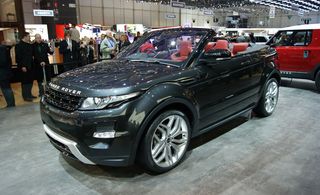
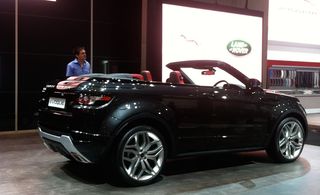

Land Rover DC100 Defender Concept
The Defender is arguably Land Rover's most iconic model. This is a real-life off-roader and its design to date has heavily reflected the car's functionality. Yet the marque feels that the model needs a makeover to bring it in line with the other cars in the family. Besides, the Defender needs to adhere to stringent safety regulations.
Redesigning the Defender, though, is complicated - its owners have a very specific idea of what this car should look like and may not necessarily embrace change. 'We haven't done a Defender for 60 years, so why on earth would we try to replicate a vehicle that looks 60 years old,' says Gerry McGovern. 'The traditionalists would say we've gone far too far but the manufacturing techniques for creating this vehicle are outmoded and it is not a modern package so it is not legal in certain markets.'
McGovern admits that the Defender's looks are a pure consequence of manufacturing and tooling at the time. 'The world has moved on,' he says adding: 'Our design DNA is simple but to develop a modern day version is very complex.'
The inside utilises durable, functional material - you can literally hose it out. It has floating seats and a centre foldable one for the dog. 'This vehicle has to be very capable - you can kick the hell out of it and it'll get up for more,' says McGovern. 'There is still more work to be done and on this particular design we will look at alternatives but the essence of what we have here is the right positioning to start.'
Jaguar XF Sportbrake
Jaguar returns to the estate segment with the XF Sportbrake - its first estate model since the X-type, which was conceived under Ford ownership and based on the Mondeo platform. Elegant in the metal, the Sportbrake is essentially an elongated XF saloon with a generous 1675l boot.
Wallpaper* caught up with design director Ian Callum at the show who had this to say: 'The main thing for me was not to do something that looked ultra functional and therefore static. As it is a Jaguar, it has to look sporty and more interesting than the average estate.'
The car, which is production ready, features two essential lines. 'One is the roof line and it is great fun having a line of this length, stretching it as far as you can, exaggerating it almost,' says Callum. 'The other is the window graphic that is expressive and gives the whole car a natural visual speed. The roof sweeps towards the back like it is floating in air.'
Estate cars, notes Callum, are cool in Europe; they are about sporty lifestyles and seem to appeal to a younger generation of motorists. 'It is for the active generation.'
On sale: Late 2012
Price: Not confirmed

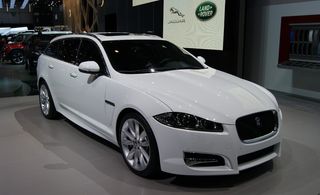

Bertone Nuccio concept
Nuccio is a mid-engine show car, created to celebrate Bertone's100th anniversary. It is very much a show car in that it is theatrical - its low profile, wedge shape design features some interesting air intakes at the front, the metal bumper strip leading the eye to the Bertone badge.
Pininfarina Cambiano
Cambiano, by Italian design house Pininfarina is a seductive, part-electric design study featuring an unusual asymmetrical door arrangement inspired by founder Pinin Farina's personal car in the 1950s.
Wallpaper* caught up with head of design Fabio Filippini at the show. 'The whole concept for the car is one that is very clean, the car speaks softly and is faithful to Pininfarina's traditional values that include elegance, purity and innovation,' he notes. 'By purity, we are talking not just of the design, but the engine and the use of materials.'
The wood used on the flat interior floor, for instance, is of the briccole, the 12m poles of European oak used to indicate the navigation channels and moorings inside the Venice lagoon. 'We took the discarded material and give it a new life,' Filippini enthuses. 'You get a piece of Venice in your car.' Plus the natural pattern of the wood adds character to the cabin.
Working with Italian producer of solid wood furniture Riva1920, the material was milled digitally, ensuring the natural holes in the wood didn't appear on the edges. 'When you mill it, you discover new holes - it is an old fashioned process but great fun,' says the designer.
The same wood has been used on the finishing of the watch manufactured in limited edition by the Swiss watchmaker Bovet 1822. The one in the car is called Cambian and is designed by Pininfarina so that it can be removed from the dashboard and worn as a wristwatch, or used as a sports timer and even a table clock.
The driver's side is higher tech and driving/driver focused, and the passenger side has two doors that open in accommodating carriage style where the interior materials used are softer, and there is less onboard functionality to clutter up the living space. 'If we adjusted it a little it would be a beautiful Maserati,' Filippini teases.
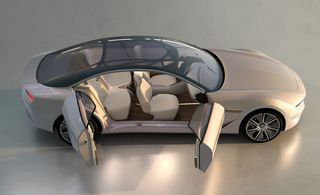
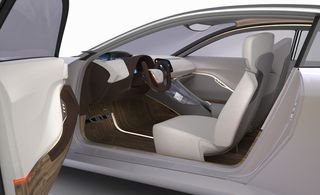
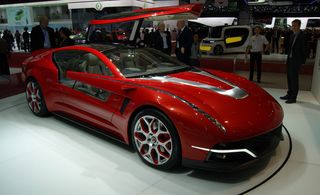
Italdesign Guigiario Brivido
Brivido is a four-seat gran turismo with a plug-in hybrid powertrain - the green engine promising supercar performance. The supercharged 3-litre V6 engine is capable of 360-horspower, zero to 60mph in 5.8 seconds and a top speed of 171mph.
Bentley EXP 9F concept
Bentley customers want the marque to produce an SUV - this is clear but the EXP 9F concept car at the Geneva show is an early design study to gauge opinion.
Based on the more sober Mulsanne, the show car's loud exterior with giant 23-inch wheels is in complete contrast to a very intelligent and fun cabin where the design team lead by Robin Page have teamed chunks of thick tan leather, hand stitched of course, with soft padded leather, floor mats with sheep skin on one side and durable leather on the other, and air vents inspired by the interior of rifles. It is a brilliant, almost ironical, play on old and new.
New head of design, David Hilton, who has only been at the firm for a month, did not hide his concerns for the exterior, reassuring Wallpaper* that there will be significant changes when we get to see the second and final version.
'The design is bold - I'll give you that,' he says, with a smile. 'What we're hearing is that it should be more agile, more SUV in quality and with a little less bling. The size and product positioning will be close. But yes there is work to be done on the exterior to get it more refined.'
Certain elements will remain; for instance the expansive panoramic roof, advanced exterior light design and grille with Hilton noting that this could be executed to be more refined so it wouldn't look so huge. 'My job now is to come up with an individual face for this car that is new to Bentley. This guy is in his teenage phase right now and is trying to find himself. The next one will be a true adult. The next one you see will be the car.'
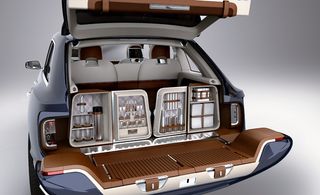
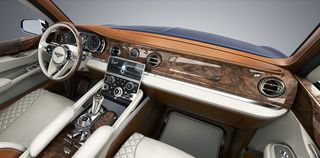

Bugatti Veyron Grand Sport Vitesse
The 8l, 16-cylinder, 1,200-horsepower Bugatti Veyron 16.4 Grand Sport Vitesse supercar is capable of 255mph, making it possibly the world's fastest convertible supercar.
Price: Circa £1.5m
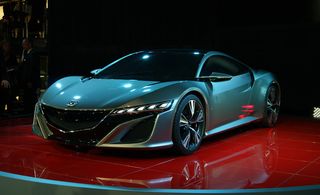
Honda NSX concept
Geneva saw the European debut for the NSX concept that heralds Honda's new supercar. Designed simultaneously at the California and Tokyo studios, this hybrid car has a very Japanese aesthetic. It features a V6 mid-mounted engine and will employ a range of new technologies including the Sport Hybrid SH-AWD (as in super handling all wheel drive) hybrid system.
On sale: Next three years
Price: Not confirmed
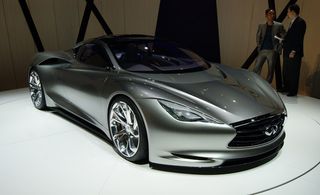
Infiniti Emerg-e concept
Infiniti completes its trio of conceptual design studies with the Emerg-e at Geneva. It joins 2009 Essence and 2011 Etherea, which together hint at what's ahead for Nissan's premium arm. 'Emerg-e has classic sports car proportions in a compact package that shows our future design direction,' says global design director Shiro Nakamura.
Designed in London at the Nissan Design Europe, Emerg-e represents a new package for Infiniti. It is also a fully engineered prototype, featuring a range-extender drivetrain mounted mid-ship.
'We are looking at how we can apply the Infiniti design vocabulary to this kind of car,' explains Francoise Bancon who leads the advanced design studio. This is a performance car with zero noise: 'It is a combination of an exclusive car that is perfectly quite, with zero emission but having the highest level of performance you would want.'
Nakamura explains that the face is very intense and that the eyes are inspired by Japan. The crescent motif is an Infiniti design feature reminiscent of the neck of the kimono. The air vents on the side are both a stylistic addition and an aero efficient feature.
The cabin has been divided into two distinct areas - Carbon Black leather on the driver and Shark Grey on the passenger side - to visually separate these two areas. With the ignition on, a stream of violet light floods from front to rear into the energy source - the battery pack.
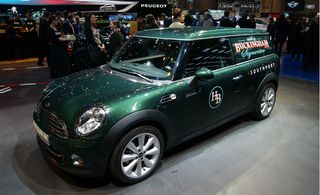
MINI Clubvan Concept
The Clubvan concept takes the Mini family into even broader segments, in this case the compact van for business and leisure
-
 The moments fashion met art at the 60th Venice Biennale
The moments fashion met art at the 60th Venice BiennaleThe best fashion moments at the 2024 Venice Biennale, with happenings from Dior, Golden Goose, Balenciaga, Burberry and more
By Jack Moss Published
-
 Crispin at Studio Voltaire, in Clapham, is a feast for all the senses
Crispin at Studio Voltaire, in Clapham, is a feast for all the sensesNew restaurant Crispin at Studio Voltaire is the latest opening from the brains behind Bistro Freddie and Bar Crispin, with interiors by Jermaine Gallagher
By Billie Brand Published
-
 Vivienne Westwood’s personal wardrobe goes up for sale in landmark Christie’s auction
Vivienne Westwood’s personal wardrobe goes up for sale in landmark Christie’s auctionThe proceeds of ’Vivienne Westwood: The Personal Collection’, running this June, will go to the charitable causes she championed during her lifetime
By Jack Moss Published